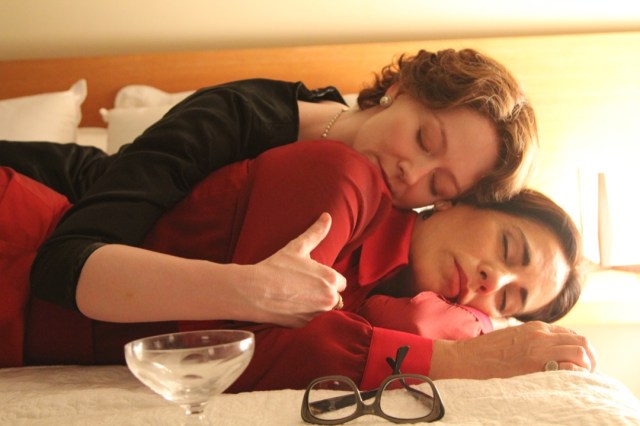 Reaching for the Moon, directed by Bruno Barreto, is a biopic about one of my favorite poets, Elizabeth Bishop (played by Miranda Otto, an actor you may recognize from her role as Eowyn in Lord of the Rings). The film follows Elizabeth as she travels to Brazil for the first time and falls in love with the famous architect Lota de Macedo Soares (played by Glória Pires), creator of Rio’s gorgeous Flamengo Park.
Reaching for the Moon, directed by Bruno Barreto, is a biopic about one of my favorite poets, Elizabeth Bishop (played by Miranda Otto, an actor you may recognize from her role as Eowyn in Lord of the Rings). The film follows Elizabeth as she travels to Brazil for the first time and falls in love with the famous architect Lota de Macedo Soares (played by Glória Pires), creator of Rio’s gorgeous Flamengo Park.
Reaching for the Moon follows Elizabeth and Lota during the fifteen years they lived together in Brazil, mainly focusing on their turbulent and passionate relationship rather than Bishop’s career. It begins with Elizabeth having trouble finishing a poem (“One Art” to be exact, which would go on to become Bishop’s most well known poem) and needing inspiration, she accepts an invitation for a trip to visit an old Vassar classmate, Mary (Tracy Middendorf), who lives in Rio with her lover, Lota. The very timid Elizabeth gets to Rio and initially dislikes everything about everything, having trouble getting along with Lota and her loud, abrupt and magnetic personality. But before Elizabeth can flee the house and bide her time before her ship sails off, she has an allergic reaction to nuts and ends up missing her boat. Oh, what a shame. She must stay for three extra weeks now. During these three weeks, Elizabeth and Lota realize the chemistry between them, and a very turbulent kind of polyamorous relationship is born for the three of them. Instead of a few weeks, Elizabeth stays fifteen years.

The film focuses on the turbulence of this relationship a great deal. The screenplay, written by Matthew Chapman and Julie Sayres, is based off of the book Rare and Commonplace Flowers by Carmen L. Oliveria. Elizabeth and Lota’s relationship provides a lens through which we view not only the good times of Bishop’s Pulitzer, Mary’s adoption of a baby and Lota’s big visions for Flamengo Park, but also the trials of Elizabeth’s crippling alcoholism, Lota’s overwhelming pride and a kind of vaguely explained 1964 Brazilian military coup.
To claim that this movie is a lesbian film isn’t quite right. It’s a film with lesbian characters, but it’s much more than that. Reaching for the Moon illustrates how creativity and power and passion shape the world through two character’s imagination and strength. It’s also an amazing display of how someone’s support of your work can affect all aspects of what you’re producing in the world. Reaching for the Moon shows Elizabeth’s poetry and Lota’s designs and how those are affected by their relationship. That’s what makes this movie so distinctly powerful and emotional.
Reaching for the Moon feels distinctly 1960s in its landscape, the stunning design and architecture (a mid-century clothing and furniture lover’s dream), and also how the character’s lesbian relationship affects them (Mary is disowned by her family, Elizabeth feels uncomfortable being held by Lota on a public beach). I also appreciated the gorgeous Brazilian backdrop, which served as a beautiful distraction from the snow falling outside my window. The fact that Portuguese is spoken in a lot of the film was an added bonus to the authenticity.
To be honest, I was 100% sold on this movie from the second Lota stepped on screen. Glória Pires steals every scene with her confidence and swagger. Her emotional portrayal of Lota de Macedo Soares’ ups and downs are particularly effective, whereas Otto’s portrayal of Bishop felt spot on. Elizabeth’s intense anxiety and lack of confidence in her own work is brought out by Lota’s support, which seemed to be the real heart of the movie.

Mary felt like a weird distraction, as though no one quite knew what to make of her character. She has a few sympathetic moments, but when she does, you understand exactly what’s going on in her mind, whereas Elizabeth stays extremely closed-off even to the audience when she’s alone. When Lota first meets Elizabeth, she has this conversation with Mary:
Lota: She’s stuck up, defensive.
Mary: She’s shy, brilliant, deceptively funny, dangerous.
Lota: Dangerous?! Haha.
Mary: There was this boy who was crazy for her. I don’t know what she did to him but he sent her a postcard saying, “Go to hell, Elizabeth.”
Lota: My god, I’m so impressed.
Mary: And then he killed himself.
But you never see this side of Elizabeth. I never truly felt like I found what made Lota fall for Elizabeth, what kept them together other than passion and lust. Perhaps if we could have seen more of Elizabeth’s internal workings (other than talking herself through lines of poetry, creepily smelling the new baby’s things and drinking alcohol) she would have held more attention. Still, Lota holds enough for the both of them.
That said, I can say with complete certainty that Reaching for the Moon made me appreciate Bishop’s poetry even more, so perhaps the sympathy is there, underneath many, many, many layers.
I accidentally spoiled the ending of the movie for myself by looking up Lota de Macedo Soares on Wikipedia while the film was buffering. Take my advice, if you don’t know their love story, just watch the movie, then Google search the two women.
Check out the trailer, be wooed by the dreamy score and soundtrack and spend a cold early spring day in bed watching this one. Reaching for the Moon is available for rental or purchase through Wolfe video:



I watched the movie with my girlfriend back in September. I didn’t like it very much. Being Brazilian and having watched Glória Pires in many telenovelas and a few movies, I knew she would be amazing in the movie, and she really was. Miranda Otto was great as Bishop, and their chemistry was undeniable, but the parts of the movie felt so disconnected. I adore poetry and I feel that the movie lacked it… Like, there were bits of Bishop’s poems, but there wasn’t a poetic feeling in the movie, and I think it’s because the director doesn’t know how to be subtle about things (I really don’t know how to explain what I mean here). The character named Mary was there just for cheap drama, which was awful. And through the whole movie there’s this sensation that something bad is going to happen, and not just the military coup…
In the book I’ve read “The more I owe you” by Michael Sledge, Mary is depicted as a more complex character and as an ongoing reminder for Lota and Elizabeth as Lota’s former partner. I found it kind of uncomfortable that Lota still kept Mary around and that Mary still wanted to be around. It is one of my favourite books and I highly recommend it as it is such a great story about two women in love and supporting each other.
I read the book about Elizabeth and Lota by Michael Sledge called,
“The more I owe you”, which is really good, and biographical and a reimagining based on their relationship.
https://encrypted-tbn3.gstatic.com/images?q=tbn:ANd9GcScFgHKrjlbYWoPa9iqYJRk-n44gOy7T3MJ8vilqmtSx1HPxy-W
It goes into Elizabeth’s motivations and psyche regarding one ardent male poet who pursued her, and anyway, read it, its brilliant, and I am definitely going to see the movie.
This looks really interesting! Thank you for telling us about this!
The most disappointing part of this movie for me is constantly wanting to call my girlfriend “strange woman!” But not being sure she’d get it
Better “strange woman” than “cookie” in my opinion.
UR STRANGE NOT ME
I saw this at Vancouver Queer Film Festival and loved it! I’m a huge fan of Elizabeth Bishop’s poetry but didn’t know too much about her life. I’m interested in reading that book, Annalou, thanks for the tip!
My favourite part of the movie: EB: “I’m not drunk; I’m crying in English.”
Indeed.
I also really liked how the movie was framed by arguably her most famous poem, One Art. That poem kills me every time.
I saw Reaching For The Moon at our local lgbt film festival last year. I thought it was visually stunning, dreamy. I actually liked how Bishop’s character was hard to read. It seemed more genuine for her, but maybe I’ve just met too many people like that ;)
Both actresses are superb, especially given that Otto had to learn a credible New England accent and Pires had to perfect her English and its intonations. Was very impressed with the naturalness of both and the chemistry between them. Would love to see Pires in another English speaking film.
Right here is the right webpage for everyone who would like to understand this topic.
You realize a whole lot its almost hard to argue with you (not that I actually will need to…HaHa).
You certainly put a brand new spin on a
topic which has been written about for many years.
Wonderful stuff, just wonderful!
Bastante pesado este juegos aunque las clases resultan brillante
This is such a beautiful movie. I was moved by the visual quality of the film (landscapes, costumes, art!) as well as stunning performances of both Otto and Pires, they are brilliant in development of the characters, they make the whole story real and relatable.
To fully appreciate this film you should read between the lines – Bishop is private and hard to read but there’s quite a lot revealed through both her actions and poetry, it’s obvious that Lota’s admiration shaped her personally and had strong influence on her work. But what I actually miss is suggestion of Lota’s inner drive, her motivation and struggles. Being very open and spontaneous, she’s surprisingly so hard to read in this. She seems so perfectly confident and strong (although a bit insecure regarding Bishop’s affection) that her tragedy and depression in the end of the movie were just surprising. One can guess the cause but I had to watch the movie twice before it really clicked, there’s just not enough information online on her to understand her better either.
Anyways, despite all the negative reviews of the movie I’ve read, it’s worth watching – finally a grown-up, elegant romance about 40-something women rocking it in the sexy 50’s, samba-style.